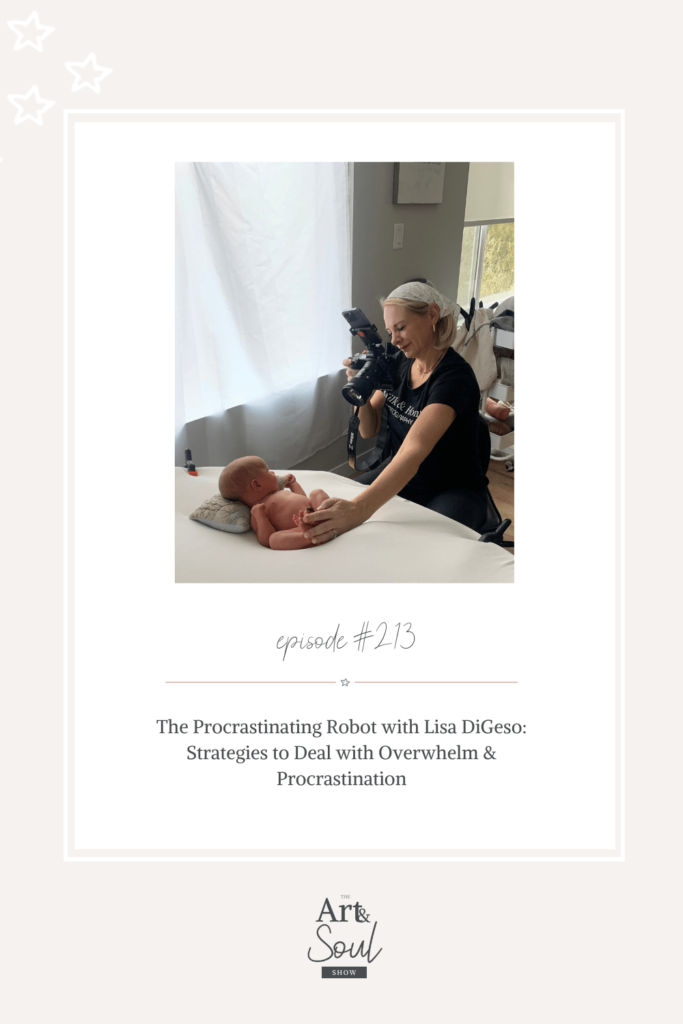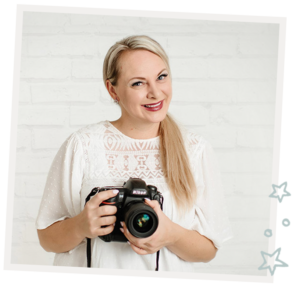The Procrastinating Robot with Lisa DiGeso: Strategies to Deal with Overwhelm & Procrastination
If you’re alive in 2024, I’m sure you’re familiar with the concept of overwhelm. It’s so common, little space robots on Mars are even feeling it (not a joke, this literally happened!) In fact, these feelings of overwhelm can be so powerful, that they paralyze us from getting anything done at all!
But with distractions, options, and ideas everywhere these days, how do we manage and cope with being overwhelmed?

Well, in today’s episode, Lisa is going to lay out a tried and true system for managing tasks in your business and avoiding the executive dysfunction that comes with having so much on our plates! She also shares common reasons we might feel overwhelmed, what context switching and executive dysfunction are and why they both contribute to overwhelm – and yes, the story of the little overwhelmed space robot.
Plus, she explains how all this overwhelm leads directly to avoidance and procrastination that can paralyze our businesses… but only if we let it! Let’s dive in!
What’s in this episode:
- [01:09] Why even space robots feel overwhelmed and how this leads to procrastination
- [03:00] All the things that can contribute to overwhelm
- [04:30] How to identify when you’re feeling overwhelmed
- [07:05] How to organize and categorize the tasks causing you to feel overwhelmed
- [15:17] What executive dysfunction is and how we can prevent it from paralyzing us
Tune in to this episode to learn how to avoid the overwhelm and keep procrastination from paralyzing your business!
SUBSCRIBE: Apple Podcasts | Spotify
Did this episode give you a roadmap to less overwhelm and more productivity for your business? Check out this episode Find Your Flow: Creating a Business That Works For Your Family with Shannon Smith that shares how another photographer started their career!
Transcript
[00:00:00] Lisa DiGeso: Welcome to the Art and Soul Show, where we dive into heart opening chats on photography, business, life, and that messy in between. I’m your host, Lisa DiGeso, a mom, a photographer, and entrepreneur. And I’ll be sharing honest conversations and advice for photographers with insight on mindset, entrepreneurship, and creativity.
[00:00:23] The goal of this podcast is for you to be able to gain insights and strategies that will get you real results. Because let’s face it, having a photography business can be lonely, but it doesn’t have to be. This is the place you can go when you need a boost of encouragement, a kick in the pants, and inspiration to pick up your camera.
[00:00:43] This is the Art and Soul Show. Hello, my beautiful friends, welcome back to the show. So today we’re diving into a subject that is near and dear to my heart and something that I often find myself going through repeatedly. So I thought it might be a great topic to share with you guys today. And that topic really is procrastination, overwhelm, and just that general feeling of being stuck.
[00:01:09] Now, I’m sure at some point you have dealt, or maybe you’re dealing with it right now, with overwhelm. And it is not fun. It’s sort of that feeling of not wanting to do anything because you don’t even know where to start. And I actually want to share a story with you that was recently sent to me to really illustrate this because I actually found it both sad and also a little bit hilarious.
[00:01:29] Now my friend sent me this TikTok and it was actually a story about this procrastinating robot from Mars. Yeah, you heard that right, Mars. This robot was sent to Mars to do all the activities up there because humans can’t be up there yet since there’s no way for them to return home in their lifetimes.
[00:01:44] So this little robot was up there on Mars and it was supposed to be working, but basically what it was doing was just sitting up there completely just twiddling its thumbs, doing nothing because it was totally overwhelmed. It was doing something that scientists actually termed As thrashing, it’s actually priority switching and it’s repeatedly priority switching so much that it causes you to use a hundred percent of your processing power on deciding what to do next that nothing ever actually gets done.
[00:02:16] So this poor little robot was sitting up there on Mars, just twiddling its thumbs because it was feeling totally overwhelmed because it just didn’t know what to do next. And to be honest, I had to laugh because honestly, this resonated with me so much because I often feel the same way. So I actually shared this with our team and my business partner, because a lot of the time we get so excited about a different idea, whether it be a new class or maybe a retreat or just something that we’ve got coming down the pike.
[00:02:43] And we get so excited about it, but then another priority comes up and then another priority comes up. You don’t actually ever start making progress on these things because you keep switching to different priorities and you just end up procrastinating everything and just feeling ultimately completely overwhelmed.
[00:03:00] And I can often even see this unfold in my photography business. I can see this happening. It could be like maybe feeling overwhelmed because I need to do a website overhaul and I don’t even know where to start. Or it could be I’m feeling overwhelmed because I have 10 sessions to edit and I don’t even know which ones to start on because I overshot them once again and now I’m feeling overwhelmed with the thought of even going through and culling them with all of the different choices and everything I have to go through.
[00:03:27] It could be feeling overwhelmed because I didn’t give accurate timelines to my clients on when to even expect their images. I could even be feeling overwhelmed because I got sick and I had to reschedule 10 sessions because I was battling a really bad cold. Or it could be feeling overwhelmed because I haven’t been having adequate rest and time off.
[00:03:45] And maybe I’ve been doing activities that I think are restful, but I really aren’t. And I’m looking at you, TikTok. Now, the thing with overwhelm is it can often make us feel really isolated. Like we’re the only one that’s going through it. And the fact of the matter is we all legitimately feel overwhelmed, whether it’s life related overwhelm or business related overwhelm.
[00:04:06] It’s just something that we all collectively can really share and relate to. So in today’s episode, I want to be covering some strategies on working through some procrastination and overwhelm, if that’s something that you’ve been going through and how I personally work through my own overwhelm, to get my tasks done and just Stop feeling like I constantly have that huge pressure on my shoulders.
[00:04:30] So let’s dive in now. Step number one is really identifying that you are feeling overwhelmed. And what exactly is the source or the cause of the overwhelm? And really the easiest and the fastest way to uncover that is to really just take an overwhelm inventory. For me, I start to feel overwhelmed when I kind of feel scattered and disorganized when I have too many projects unfinished, things are piling up ideas that I haven’t written down.
[00:04:56] I’m worried I’m going to forget them, but I also resist writing them down. And my real trouble really starts when I do resist the ease of organization and just putting pen to paper. So even before I start, I need to make a list of what is causing the overwhelm and where I’m feeling stuck and what I’m actually procrastinating on.
[00:05:15] And these can often be a multitude of things. That when left in your brain feel a lot heavier and bigger than they actually are. So what I want you to do is we’re going to grab a piece of paper and literally just get out everything that is in your brain that’s causing you overwhelm. This could be all the tasks you need to do.
[00:05:33] It could be overwhelming areas of your life and pressure that you’re under. So on this piece of paper just right at the top, brain offload, and we’re just going to write out everything Everything that is causing us stress, those tasks that are stuck in our brains, and those thoughts we just keep looping on.
[00:05:51] So really, in order to do this, you’re going to want to set aside some dedicated time. It could be 15 minutes to half an hour. You’re going to want to find a comfortable and quiet space where you can just focus without distraction. You’re going to just want to, uh, Allocate sufficient time to really complete this inventory thoroughly.
[00:06:08] So you’re going to need either a pen, paper, or a pencil, or maybe even a digital device where you can record your brain offload inventory. This really is your brain dump, or brain offload, I like to call it. So we’re going to start by emptying your mind of All those tasks, those thoughts, those responsibilities that are really causing you stress and overwhelm.
[00:06:28] And I want you to write down everything that comes to mind without filtering it or editing it. Now if you want to pause this episode right now and just get it all out. You have my permission to do so. Now if you’re just coming back, next I want you to look at everything that you just wrote down and look at what you can take off your plate and just kill those tasks.
[00:06:49] Now it doesn’t mean you have to kill them forever, but it just doesn’t have to happen right now. Maybe you’re just stressed out about some things that are completely beyond your control and those can get set aside too. Next we’re going to grab a fresh sheet of paper and we’re going to draw a line down the middle of it.
[00:07:05] And on the left, you’re going to write tasks you are overwhelmed with. And on the right, you’re going to write, what can I do about it? And you’re going to start going through that list of the things that are overwhelming you. Maybe you’re overwhelmed because your website needs an overhaul. And that seems so daunting.
[00:07:23] Maybe it’s a new platform and you don’t even know where to start and you don’t even know what copy to use or what images to use. So that whole thing’s just feels enormous and just really daunting. This is one I actually kept looping on for months. Until I actually made a list of what it was that was overwhelming me.
[00:07:40] So using my website example, this is how I got over it. I wrote down on that. One side, what was causing me the overwhelm? And then on the right side, the action step I could take. So for example, I really wanted to switch to a show it site, but. Every time I opened up the software, I got super overwhelmed that I just didn’t know how to use it.
[00:07:59] And I didn’t even know what I wanted my website to look like. I didn’t know what to put on it. So really step number one for me on the left, I wrote, what do I want my website to look like? And then on the right, I wrote under the action, I wrote find websites I like or themes that I like. So I can start there.
[00:08:17] So number two was, I didn’t know how to use the software. So the action step was find a tutorial that can teach me how to use it. And honestly, it was only like a half an hour tutorial and I was off and running. So it really wasn’t as scary as I thought it was going to be. Number three, I didn’t know what to write on my website.
[00:08:36] So instead of just bringing up the entire website and just having a blank page and a cursor staring at me, I actually took some time beforehand to really think about my story and my customer experience and what I offer before I’m actually in the software. It was easier for me to do that instead of just staring at that blank screen.
[00:08:56] So by doing this, I was really able to break down this massive overwhelming project really into Action steps that I could take that could really help start making progress. Now, for me, most of my overwhelm really falls within different categories of my business, because I don’t know which one to do first.
[00:09:12] And I just end up scrolling TikTok, or just spending this weird circuit of check Facebook, check Instagram, check email, check TikTok. And I just couldn’t spend hours in this silly little circle loop. And that’s because I’m really not sure what tasks I need to do next. And like that little robot, it has me just twiddling my thumbs.
[00:09:30] So, this is where prioritizing our tasks come in. So, it’s really important that we go through and we categorize them based on their urgency and which ones I can just remove from my list too because then we have that roadmap on what we can do next and really what can wait. So, next we’re going to look at all the tasks and everything on that brain offload list that are left and we’re going to categorize them.
[00:09:54] So, grab another piece of paper and you’re going to draw a line down the center and we’re going to draw a line through the middle so we have four quadrants. Now on the top left I want you to write urgent and important. On the top right, you’re gonna write urgent, not important. On the bottom left, you’re gonna write not urgent.
[00:10:14] On the bottom left you’re gonna write not urgent and important. And the bottom right you’re gonna write non urgent and non important. So the ones at the very top, the urgent and important, those are the big hitters and probably the ones that are really stressing you out. Now, this matrix is actually called the Eisenhower Matrix, and what it does is it helps you categorize tasks based on their urgency and their importance.
[00:10:39] So we’re systematically sort of sorting these tasks into different quadrants so you can really gain clarity on what you need to do immediately and really what can wait. So let’s break down each quadrant. So urgent and important. This is that quadrant one. These are tasks that are both urgent and essential for the success of your photography business.
[00:10:58] These are those high priority tasks that demand immediate attention and really directly contribute to the business’s growth and client satisfaction. Now, some examples of this would be editing and delivering photos for a client within your greed timeline. It could be responding promptly to client inquiries or really addressing any issues or getting payments.
[00:11:18] It could be finalizing contracts and agreements with clients for upcoming photo sessions or their events. Next is urgent, but not important. This is quadrant number two. Tasks in this quadrant are urgent, but they may not directly align with your long term goals or your priorities. So they do require immediate attention, but they might not contribute significantly to the overall success of your photography business.
[00:11:41] Examples of this could be maybe sending in your camera for a cleaning, it could be doing administrative tasks like organizing files, maybe switching over software, could be responding to non critical emails, It could be attending to maybe unexpected client requests that don’t align with your standard services or your offerings.
[00:11:59] Maybe it’s additional editing requests or maybe someone wanting a last minute session. Now quadrant number three is not urgent, but important and tasks in this quadrant are important for the longterm success and growth of your photography business, but they might not have immediate deadlines or require urgent attention.
[00:12:18] These are tasks that really can contribute to professional development, client relationships, and overall business strategies. And so examples of this would be developing a social media marketing plan. It could be investing time in networking and building relationships with other professionals in the industry.
[00:12:35] And it could be learning or taking a new online class. Now, the last quadrant is the ones that are not urgent and not important. This is quadrant four, and the tasks in this quadrant are either not urgent and also not important for the success of the photography business. These are really the low priority tasks that can be minimized or eliminated so you can focus your time on the more important tasks.
[00:12:59] Energy efficient and the ones that are really meaningful activities for your business. So examples of these would be spending lots of time on social media or browsing unrelated websites during your work hours. Could be engaging in non business related activities or hobbies. during your business hours too.
[00:13:17] It could be pretending to work when you’re really just needing a day off and it could be online shopping. So it feels like you’re making progress in your business, but you’re actually not. So now that we understand the four quadrants of the Eisenhower matrix, we want to discuss how to effectively use this tool to prioritize our task and overcome procrastination.
[00:13:38] So step number one is you really want to evaluate, evaluate, The tasks. So really take a close look at the tasks on the overwhelm inventory and assess which quadrants they fall into. So by now, after we’ve done that matrix, you should have been able to have all of those filled into those different quadrants.
[00:13:56] And if you haven’t done that yet, you might want to pause so you can put them all there. So once you’ve done that, you want to just be honest with yourself about the urgency and the importance of each task. If it’s falling into urgent and important, these are the things that you really want to do right away.
[00:14:12] That way you can prioritize them. You want to start by tackling these tasks that are in the urgent and the important because they’re going to be the ones that affect your business the most and the ones that you’re going to want to get done quickly because maybe people are relying on you or waiting on you.
[00:14:27] These are ones that are really crucial to your goals and honestly, probably your mental wellbeing. The next one is you’re going to look at the urgent and not important, and these are ones that can be delegated or postponed. These are ones that maybe you could have someone else do, you can postpone it for later.
[00:14:42] These are ones that are going to derail you from focusing on what really matters. Next we’re going to hit the important but not urgent tasks, and these are tasks that you probably should be scheduling. These are setting aside some time to ensure that they get that job done. Attention they deserve, but they don’t have to be done right, right, right away.
[00:14:59] They’re not the immediate priority. So you just want to set aside some dedicated time in your schedule to work on these tasks just to avoid procrastination or just feeling overloaded with them again. And the last one is the not urgent and not important tasks. And these are ones you can just eliminate or minimize, let them go.
[00:15:17] So by freeing up these time from these tasks, you can really create the space to focus on what really matters for you. Okay, so now that we’ve kind of covered the overwhelm inventory, let’s talk a little bit about executive dysfunction and context switching and really how those both can contribute to feelings of overwhelm.
[00:15:33] Now executive dysfunction refers to difficulties with executive function, and basically what this means is these are the mental skills that help you get things done. This is things such as planning. This is organizing, prioritizing, controlling impulses. And when the dysfunction occurs, we actually start to struggle with managing our time effectively with staying focused and actually completing our tasks.
[00:15:57] So like that little robot on Mars, we get overloaded too. And that’s what executive dysfunction is. So the next is context switching. And what that is, is that’s when you’re jumping and shifting your attention rapidly between different tasks. It’s like trying to juggle multiple balls at once. And really it can lead to decreased productivity and really a lot of feelings of overwhelm.
[00:16:19] So really how do executive dysfunction and context switching relate to that overwhelm? When we experience executive dysfunction, we actually find it really challenging to prioritize tasks. And so this kind of gives us that scattered approach to work, and that’s when we start to feel that overwhelm. And we start to feel like we don’t know where to start.
[00:16:39] And additionally, when we end up overwhelmed, we really start having a difficult time with controlling impulses that maybe will start resulting in procrastination or avoidance behavior. That’s like doom scrolling instead of getting our work done, or just jumping and looping from that. Loop of going to TikTok to Facebook, to Instagram, to your email, and just keeping doing that where it feels like maybe you’re doing something but you’re actually doing nothing at all.
[00:17:04] So when we start jumping from task to task, it just really never gives us that sense of productivity. And we end up just like our little robot friend just sitting there, overwhelmed. Now, contact switching can really cause overwhelm into overdrive because it disrupts our focus and our concentration. So constantly mentally switching really drains our brain power and our energy.
[00:17:27] And honestly, it just feels like we can’t get anything done. So in order to combat all of this, I really want to give you some strategies just for managing your executive dysfunctions. You can stay focused and feeling like you can plan things and organized and really get You can avoid that context switching, which ends up leading into overwhelm.
[00:17:47] So number one, what we’re going to do is we’re going to be chunking tasks. And what this is, is it’s basically batching. It’s breaking down tasks into smaller, more manageable chunks by focusing on that one small task at a time. You’re really reducing. that brain overload and you’re making progress without feeling overwhelmed.
[00:18:05] So for example, if you have five sessions to edit, I’ll often chunk the task like culling and just get them all done at once instead of switching back and forth to all sorts of different things, checking my email while I’m trying to cull a session is I just focus on that one task and get it done. Next number two is time blocking.
[00:18:23] This is when we allocate specific blocks of time for the different tasks or categories of work. This helps minimizing context switching by allowing us to focus on one type of activity at a time. So when I actually started allocating editing time into my workday, instead of during my evenings, my editing workload seemed way more manageable.
[00:18:42] I was He taking basically Thursdays, and I was just saying, okay, this is my editing day. If I’ve got three sessions to edit, these are my windows. And I have to make sure that I am not over delivering and giving way, way more images than I should be, because this is the only time that I have to do this. So when I had those constraints, it actually gave me a lot more freedom to stop over delivering and really spending so much time in the editing and honestly, just feeling overwhelmed with it all.
[00:19:11] Number three is prioritization. So when we use the techniques like that Eisenhower matrix to prioritize our tasks based on the urgency and the importance, like we talked earlier, this really helps you focus your energy just on the most critical tasks while minimizing the overwhelm caused by trying to tackle everything all at once.
[00:19:31] Number four is mindful practice. Now, maybe you’re a little bit woo, or maybe you’re not, but it’s also been proven that incorporating mindful techniques into your routine can really, really help you with your stress management and it can improve your focus. So what I try to do and I. Friend, I’m not perfect, I’m still working on this, and I miss days too, but I really try and add in about 10 minutes of meditation to start my work day.
[00:19:56] So instead of coming into the office and feeling really scattered and frazzled, I feel like I take that time to just reset and focus before I start working. So techniques like deep breathing and meditation or even mindfulness exercises can really calm your mind and really reduce those feelings of overwhelm.
[00:20:13] Number five is limiting your distractions and this is identifying and minimizing those distractions in your environment to help you maintain focus and reduce that contact switching. Now this could be turning off all the notifications on your phone, all those dings in your computer. It could be setting specific work hours.
[00:20:30] It could be letting your family know that you’re in work hours or creating a dedicated workspace where you only go and work. Number six is setting boundaries. And I love talking about boundaries because they really are essential and they’re so, so important. We need to establish those clear boundaries around your time and your energy in order to prevent overloading yourself.
[00:20:51] You need to actually set work hours and you need to set off work hours too. You need to learn to say no to those tasks or commitments that really aren’t essential. And you really need to protect your working time. Lastly, you need to schedule those days off too. My friend, Rest is absolutely essential to the longevity of our businesses, and it is a marathon for a business.
[00:21:13] It’s not a sprint, so you need to make sure that you are taking those rest days, too. So my friend, if you have been feeling overwhelmed and stuck, It is 100 percent okay because we have all been there. I get there repeatedly and I have to come up with my tools and take out my tools so I can start battling my overwhelm myself too.
[00:21:33] So I really hope today’s chat has helped you with some tools that you can start adding to your toolbox when your life and your business starts to feel a little bit too much. I am sending you so much of my light and my love today and every single day. We will see you next time.
[00:21:54] I wanted to take a moment to ask you a little favor. I so appreciate you spending your time with me and tuning in and listening to the show. I would be so incredibly grateful if you could take a quick moment to leave a review on Apple podcasts. Your review helps other photographers discover new podcast and learned how to grow their own photography businesses and gain confidence to go after their dreams.
[00:22:18] It also means the world to me personally and helps me know what content you find most helpful. Thank you so much for your support and for being part of our amazing community.
share the love
[Sassy_Social_Share]
2 Comments
Leave a Comment
recent
Podcasts

I'm
Lisa DiGeso
I’m on a mission to create uplifting online experiences for photographers ready to elevate their art, their business and their mindset.(...and have fun along the way!)

























Hi Lisa! Just wanted to say I love your podcssts and always look forward to seeing them in my inbox. Im just beginning my photography journey and feel this ‘overwhelmed’ feeling so much. I feel like this is me 100 percent! Thank you for all of the helpful tips.
Thank you so much for this kind comment! WE are thrilled you have found us on your journey to becoming the newborn togs you aspire to be!